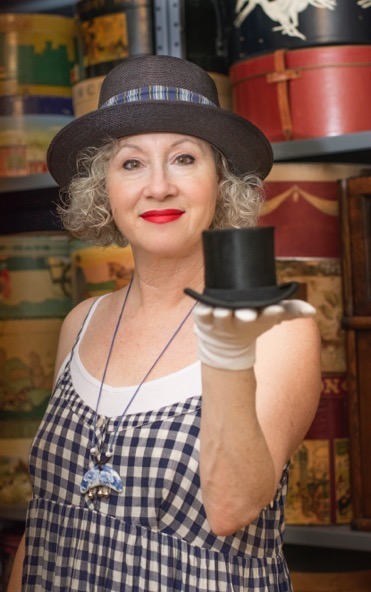The idea of wearing a hat to complete an outfit came at an early age for Wendy Ann Rosen.
Her mother Mim often made exquisite outfits for her Madame Alexander and Barbie dolls. When she made outfits for Wendy Ann, she would often use the remaining fabric to trim a matching hat. Wendy Ann developed a life long affection for wearing hats.
On the occasion of her 7th birthday party she had a hat-making contest and guests brought home their creations as a party gift. On her 8th she had an Alice in Wonderland theme and dressed as the Mad Hatter. By the 1980's Wendy Ann's love of hats developed into a signature look that included a well-chosen hat. Working as a makeup artist, she was represented by the Cloutier Agency in Los Angeles and worked in London from 1987-89. Her mother Mim went to London to visit Wendy Ann. Mim had a keen interest in fashion history and often went to the library at the Victoria and Albert Museum to study the history of underwear. At the time, she also encouraged Wendy Ann to learn more about hats. When Wendy Ann relocated back to Los Angeles, Mim referred her to Sandy Rosenbaum, Curator of the Doris Stein Research Center for Costume & Textiles at the Los Angeles County Museum of Art.
Through Wendy Ann's research at their library she was able to learn who the most famous milliners were and the ever-changing hat styles of any given period. This research propelled her to start her collection with a very clear vision. She amassed one of the most extensive and comprehensive hat collections of the 20th century in a very short time. Wendy Ann also volunteered for several projects for LACMA's Costume Department. One project included the organization and cleaning of a collection of miniature historical hat recreations.The collection, designed by the late flamboyant milliner Mr. John, was part of his estate acquired by LACMA. Wendy Ann obtained a portion of the estate that the museum was unable to keep. "My research and the extent of my collection would not have been possible without the support of LACMA's Costume Department," credits Wendy Ann.
The House of Hats collection focuses on women's hats from the most prominent milliners of Paris and New York during the 20th century.
Represented in the collection are all aspects of 20th century hats, including couture designers who also had hat labels, such as Dior and Schiaparelli. It also includes hats from the hat salons of department stores, hat manufacturers and small boutique milliners. Additionally, the collection includes men's hats, ethnic hats, tools of the trade, related printed material and the world's most extensive collection of hatboxes.
While living in London Wendy Ann had the good fortune to be introduced to renowned milliner Stephen Jones. Many years later he asked Wendy Ann to loan several of her House of Hats pieces for the 2009 exhibition
HATS: An Anthology by Stephen Jones at the Victoria and Albert Museum in London.
Hats from the House of Hats collection have also been featured in shows at
- The Philadelphia Museum of Art in Hats! Ahead of Fashion: Hats of the 20th Century
- The Los Angeles County Museum of Art exhibition, A Century of Fashion 1900-2000
- Fashion Institute of Design and Merchandising exhibition, Hollywood Master Designers
In the book that accompanies the exhibit HATS: An Anthology, Stephen Jones states, "This is my personal anthology of hats, a mish-mash of dates, places, stories and illusion that are squished into a sense of order by a mad-hatters logic. It is by no means a learn encyclopedia nor an accurate chronology. I will leave that to other more erudite authors."
Wendy Ann hopes to create that encyclopedia with a research and database project to document all aspects of the history of hats. It would range from hats in fashion from all time periods, to ethnic, religious, military and occupational. This project would detail all materials and tools used in the making of hats, plus related print and archival film material. Gathering this extensive wealth of information will be possible by collaborating with museums, academic institutions, private researchers and collectors who specialize in these specific areas.



